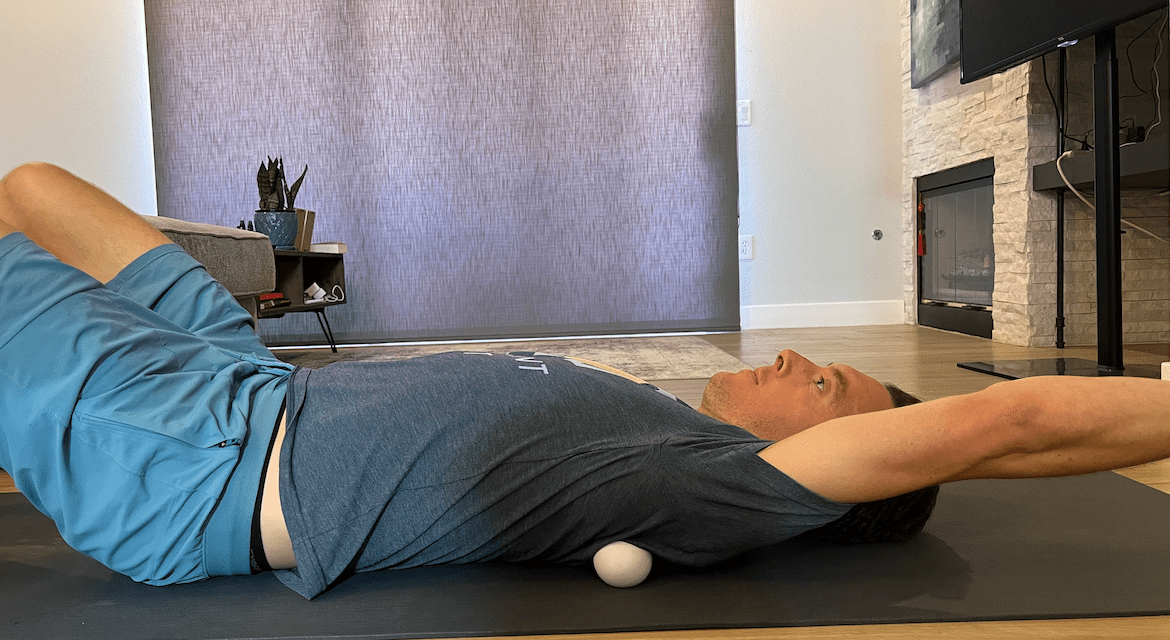A rotator cuff tear is a one-way ticket to pain and loss of mobility. These stretches can help prevent that.
We use our shoulders for just about every little thing we do: reaching for a can in the back of the cabinet; putting a book on a high shelf; slipping our arm into a sleeve; brushing our teeth. So when you have a bum shoulder, it’s, well, a big bummer.
Most people with shoulder pain have some kind of rotator cuff tear or injury. Problems with the rotator cuff—one of the most important parts of the shoulder—are super common (more on why later). Every year, more than 2 million Americans see their doctor complaining of rotator cuff pain, according to the Cleveland Clinic.
While preventing a rotator cuff injury isn’t always possible, showing your shoulder some love in the form of daily rotator cuff stretches can certainly lower your chances. Read on to learn more about the rotator cuff, including why it’s prone to pain, the best stretches to keep it long and limber, and what to do if you end up with an injury.
What is the rotator cuff, exactly?
“The rotator cuff is a group of relatively small muscles [and tendons] that attach to the front and the back of the shoulder,” says Anna Hammond, DPT, OCS, PCES, a physical therapist at Core Exercise Solutions.
“The shoulder joint is a ball and socket joint,” so the rotator cuff muscles “work together to help keep the ball centered in the socket,” Hammond says. In other words, it holds your shoulder in place and stabilizes the joint, so you can do things like lift your arms or reach overhead.
Why is the rotator cuff prone to injury?
“The short answer is most people have tight or weak rotator cuff muscles,” says Grayson Wickham, DPT, CSCS, founder of the Movement Vault.
Typically, tight rotator cuff muscles on the front of the shoulder (including the pectoralis minor) will pull the shoulders forward (i.e., out of proper alignment), he says. The rotator cuff muscles on the back of the shoulder can also be weak or unstable.
This lack of stability usually has to do with repeated poor posture (think: slumping in front of a laptop nine hours a day), Wickham says. Not actively stretching or strengthening the muscles also plays a part.
Problem is, poor shoulder mobility and stability sets off a damaging domino effect, something Wickham calls the “joint pain and injury cycle.” The cycle is:
- Tight or unstable shoulder muscles cause compensations in your rotator cuff
- These compensations lead to joint wear-and-tear (in this case, micro-tearing of specific rotator cuff muscles such as your supraspinatus)
- This joint wear-and-tear eventually leads to pain and injury
Making matters worse, we depend on the rotator cuff for a lot of everyday movements (think: combing our hair, pushing a vacuum) so it gets a lot of wear-and-tear. Over time, this overuse damages and weakens the shoulder, making it even more susceptible to injury, according to Harvard Health Publishing.
On top of all this, the movement of the rotator cuff involves the sequencing of many muscles including the scapula (shoulder blade), the humerus (upper arm bone), and the rib cage, Hammond says. “If one component isn’t working well, the rotator cuff can easily get pinched in the joint space or set up to overwork,” she says.
How to know if you have a rotator cuff injury
Tears are one of the most common rotator cuff injuries. They can happen accidentally, say, if you fall, or they can be a byproduct of wear-and-tear from repetitive activities and regular aging.
Symptoms of a rotator cuff tear include, per the Cleveland Clinic:
- Difficulty raising or moving your arm without pain or discomfort
- General weakness in your shoulder joint
- Less range of motion in your shoulder
Tendonitis (or inflammation of tendons in the shoulder) is another common rotator cuff problem. When it’s severe, tendonitis can even cause a rotator cuff tear.
Symptoms of rotator cuff tendonitis include, per Harvard Health Publishing:
- A dull ache around the outside tip of the shoulder that gets worse when you push, pull, reach overhead, or lift your arm up to the side
- Pain when you lie on the affected shoulder
Can rotator cuff stretches prevent an injury?
The short answer: yes, in part. “The most effective way to prevent rotator cuff injuries is to improve your overall shoulder mobility and stability,” Wickham says. This means making sure the muscles on the front and back of your shoulder are strong and flexible.
“The most effective way to prevent rotator cuff injuries is to improve your overall shoulder mobility and stability.”—Grayson Wickham, DPT
Targeted stretching is part of this equation. “An effective shoulder mobility program will include specific rotator cuff active stretches,” Wickham says. The key word being active. “Static stretching will not improve your rotator cuff range of motion or stability,” he says.
The other pivotal piece for preventing a rotator cuff injury is strengthening the shoulder muscles. Muscle activation exercises will help enhance rotator cuff mobility and stability. specifically with overhead movements, Wickham says.
Hammond agrees: “it’s about a well-balanced weight training program that helps make sure your scapula moves well in all planes of motion and with control.”
“Typically, focus on rib cage mobility and eccentric lengthening exercises of the serratus, pecs, lats, and subscap,” Hammond says. “The eccentric focus of an exercise helps give you length and strength” in these muscles, she says. Both are necessary for staying injury free.
Other benefits of rotator cuff stretches
“In addition to injury prevention, performing rotator cuff active stretches and muscle activations will also improve your performance in your daily life activities,” Wickham says.
A few everyday things you can do with more ease (and less pain) when your rotator cuff is in tip-top shape:
- Reach high in your cupboard to get something
- Open a door
- Lift your groceries
- Brush your hair
Adding rotator cuff stretches to your regular routine can also level up your fitness in the gym or in your sport, Wickham says. You’ll be better at push-ups, bench press, pull-ups, throwing a baseball or football, or swinging a tennis racket, just to name a few.
Best rotator cuff stretches to prevent injury
These shoulder exercises, which you can do at home, are recommended by Wickham to build range of motion and flexibility, and improve stability and mobility within the shoulder joint to help prevent injury in your rotator cuff. For the best results, incorporate them into a well-balanced strength-training routine.
1. Rotator Cuff Muscle and Fascia Active Release Lying With Ball
This targets and unlocks your posterior rotator cuff muscles (the ones in the back) by decreasing neurologic muscle tone, Wickham says. We like to use a Trigger Point Massage Ball for fascia stretches, but a lacrosse or even tennis ball will work just as well.
- Start by lying on your back with one arm lifted straight overhead.
- Place the mobility ball on your rotator cuff muscles of your overhead arm. To find these muscles, take your opposite hand and reach over your shoulder to find the spine of your shoulder blade.
- Place the ball underneath this spine. The ball should be on the bottom half of your shoulder blade.
- Internally and externally rotate your shoulder. To do this, point your thumb upward toward the ceiling, and then rotate your shoulder, pointing your thumb downward as far as you can toward the ground.
- You can also explore other areas on your rotator cuff by moving the ball slightly in either direction.
- Continue this shoulder rotation movement while lying on the ball for 2 minutes. Switch and repeat on your other shoulder.
2. Sleeper Stretch Active Stretch
“This active stretch and activation exercise targets the back of your shoulder,” Wickham says. “It maximally stretches and activates your posterior rotator cuff muscles and improves shoulder rotation.”
- Start by lying on one side with a slight bend at your hips.
- Your body will be in a V position. Rest your head on top of a pillow, foam roller, or yoga block.
- Point your bottom forearm and hand directly at your hip crease. This will show you where your arm should be.
- Keep the back of your shoulder and elbow of the bottom arm on the ground the entire time.
- Take your opposite hand and place it on the top of your other forearm and push down as far as possible.
- You should now feel a maximal stretch in the back of your shoulder that is on the ground.
- While staying in the stretch, contract these muscles by trying to push your wrist into your opposite hand that is holding your forearm down and providing resistance.
- Hold this contraction for 20 seconds.
- Next, relax the muscles, but stay in the stretch and contract the muscles on the other side of your shoulder by trying to push your hand and forearm towards the ground even farther, as far as possible.
- Hold this contraction for 10 seconds.
- That’s 1 rep; complete 3 reps. You should be able to get a little deeper into the stretch with every repetition. Then switch arms.
3. Reverse Snow Angels Standing
This is a great move similar to shoulder flossing to improve full active range of motion and stability of your shoulders in numerous positions, because it targets all of the muscles around your shoulder blade and shoulders.
- Stand with your feet shoulder-width apart.
- Push your hips back as far as possible until your chest is parallel to the ground or you feel a stretch in the back of your hamstring muscles.
- Keep your back flat the entire time. With your hands by your side, and palms facing up, extend your shoulders upward as high as possible.
- Bend your elbows and bring your hands behind your back, trying to touch the bottoms of your opposite shoulder blades.
- Straighten your elbows, flip your palms down, and spread apart your shoulder blades while bringing your arms out to the side and then overhead as far as possible.
- Once your arms are maximally stretched out overhead, reverse the above steps, by pinching your shoulder blades together as you move your arms out to the side and then back down to your side.
- Flip your palms upward and extend your shoulders as high as possible upward.
- That’s 1 rep; perform 3 sets of 3 reps.
“The goal of this exercise is to move your shoulders and shoulder blades through their maximum pain-free range of motion,” Wickham says. So if you have pain at any point, modify the stretch until the range of motion is more comfortable for you.
4. Shoulder Flexion Active Stretch
By focusing on the front and side of your shoulder, specifically your lat and rotator cuff muscles, this move improves overhead mobility and stability, according to Wickham. It’s also a great way to stretch out shoulder knots.
- Start on your hands and knees. Place one hand with your thumb facing upward onto a box, bench, or piece of furniture.
- Keeping your elbow straight the entire time, push your chest down to the ground as far as possible until you feel a maximal stretch in the front and side of your shoulder.
- While staying in this stretch, contract the shoulder muscles by driving your hand and arm into the box and holding this contraction for 20 seconds.
- Next, relax the muscles, but remain in the stretch. Contract the muscles on the other side of your shoulder by trying to lift your hand up off of the box as high as possible. You probably won’t be able to lift your arm because it is maximally stretched (which is totally normal), but the idea is to tell your muscles to try. Hold this contraction for 10 seconds.
- This equals 1 rep; do 3 reps, then switch arms.
5. Cross-Chest Posterior Shoulder Eccentrics
This active stretch and activation exercise targets the back of your shoulder to improve posterior rotator cuff mobility and stability, Wickham says.
- Start by lying on your side with one arm directly out in front of you, palm facing up.
- Contract the muscles on the back of your shoulder on your straight arm by pushing the back of your hand and arm down into the ground.
- While holding this contraction, slowly lower your opposite shoulder and chest down to the ground as far as possible. This should take you about five seconds.
- Make sure to continue to press your arm down into the ground, contracting this muscle the entire time. You should feel it in the back of your shoulder.
- Next, move your arm upward about 6 inches and repeat the steps above.
- This equals 1 rep. Complete 10 reps and repeat on the other side.
6. Pectoralis Active Stretch
If you’ve ever done a chest stretch through an open doorway, this move is very similar. It adds some contractions to the muscles on the front of your shoulder, specifically your pectoralis muscles, to not just stretch your front shoulder but boost its stability, too.
- Start by lying on your stomach with one arm straight out to your side at a 90-degree angle from your body and palm down.
- Using your opposite arm for support, lift and rotate your opposite hip and leg off of the ground, as far as possible backward. This will increase the stretch in the front of the shoulder of your straight arm.
- While staying in the stretch, contract the shoulder muscles by driving your hand and arm into the ground. Hold this contraction for 20 seconds.
- Next, relax the muscles, but stay in this stretch. Contract the muscles on the back of your shoulder by trying to lift your hand and arm up off of the ground as high as possible. Hold this contraction for 10 seconds.
- If you are deep into the stretch, you will not be able to lift your arm much (this is a good thing). Continue to contract the muscles on the back of your shoulder.
- Briefly come out of the stretch and bend your elbows 3 times. Then place your arm back on the ground, but move it about 6 inches upward. Repeat the same steps above.
- Continue this movement pattern, moving your arm upward each time until it is almost directly overhead. The higher you move your arm upward, the less you will be able to rotate your body.
- Repeat on the opposite side.
Exercises to avoid with an injured rotator cuff
While rest is key for recovery, you shouldn’t stop moving your shoulder altogether. This can cause “frozen shoulder,” a condition that occurs when shoulder tissues shrink and reduce its range of motion, according to Harvard Health Publishing. Staying active will help prevent this problem and keep your shoulder limber.
That said, you’ll also need to be careful about which exercises you choose to do—you don’t want to worsen your injury (or your pain). Certain exercises, like overhead movements (or anything that involves raising your arms) and horizontal pushing movements, can aggravate a rotator cuff injury, Wickham and Hammond say.
Some exercises to avoid with a rotator cuff injury:
- Push-ups
- Pull-ups
- Reverse fly
- Overhead press
- Arm raises with arms out to the side (palms down or thumbs down)
- Dips
- Bench press
- Stretches that involve reaching behind the back/overhead/across the front of the body
Other (perhaps surprising) exercises that add strain to a bad shoulder include, per the Cleveland Clinic:
- Deadlifts (they can pull your arm out of your socket and place a ton of tension on the rotator cuff)
- Shrugs (they pull down on your shoulder)
- Squatting with a barbell (resting the bar across your shoulders can stress the rotator cuff)
Still, everyone (and every injury) is different. “The specific stretches and exercises to avoid depend on your extent of damage and your current shoulder mobility and stability level,” Wickham says. “Let the discomfort down your arm be your guide,” Hammond says. Simply put: if something hurts, stop doing it.
Simply put: if something hurts, stop doing it.
Alternatively, you can also accommodate your shoulder by modifying (in this case, reducing) the range of motion of an exercise or stretch, Wickham adds. As you recover, you’ll gradually rebuild range of motion and strength.
FAQ
What if I already have a rotator cuff injury?
Sometimes even when you take care of your shoulders (read: stretch and strengthen them regularly), injuries still happen (argh). Now what?
While it might take some time, most injuries can heal with a little help. It usually takes two to four weeks to recover from rotator cuff tendonitis or a small tear, according to Harvard Health Publishing. For more serious tears, the healing process may last several months.
Either way, with patience and some TLC, you can successfully recover from a rotator cuff injury (and relieve rotator cuff pain). Here’s how, per the Cleveland Clinic:
- Rest (and maybe an arm sling) to give your overused shoulder much-needed downtime.
- Nonsteroidal anti-inflammatory drugs (NSAIDs) to limit pain and swelling.
- Steroid injections to ease pain and swelling.
- Physical therapy for rebuilding range of motion and strength.
Can a rotator cuff heal on its own?
Luckily, many rotator cuff injuries—including tendonitis and tears—can heal with physical therapy (and without surgery), according to Harvard Health Publishing.
Case in point: 8 of 10 people with partial rotator cuff tears make a full recovery using conservative treatments (think: ice, NSAIDs, physical therapy), per the Cleveland Clinic.
Still, “not all rotator cuff injuries are created equal,” Hammond says. “You can have different thicknesses or number of muscles involved.”
In other words, whether you can get better on your own depends on “the extent of damage, a.k.a., muscle tearing,” Wickham adds. Less serious rotator cuff tears (like grade one or two tears, for example) can be successfully rehabbed with the support of a physical therapist, he says.
“An effective rotator cuff tear rehab program will not only help you decrease your shoulder pain, but will also fix the root cause of your rotator cuff tear, which in most cases is poor shoulder mobility and stability,” Wickham says.
“It will also focus on other areas of your body as well such as upper back mobility, core stability and even hip mobility,” he says. “Poor mobility in these areas will cause extra compensation in your shoulders, which will typically lead to wear-and-tear and eventually shoulder pain and injury.”
On the other hand, more severe injuries, like grade three tears, will typically require surgery, Wickham says.
What is the best position to relieve rotator cuff pain?
An injured rotator cuff can be pretty painful. You might find it difficult to get comfortable in any position.
“Typically, lying on your injured shoulder is the worst position,” Wickham says. Here’s what to do instead to alleviate pain when lying on your side:
- Leave your arm by your side while sitting (or standing). Raising your arm overhead can worsen the discomfort.
- When lying down, lie on your opposite (i.e., healthy) shoulder. If you still have pain in this position, put a big pillow under the top/affected arm to help support it/prevent it from getting pulled across your body.
“Lying on your back is often painful too,” Hammond says. To help:
- Put a pillow under your affected arm with your hand on your stomach.
- Place a small towel behind the back of shoulder (the idea isn’t to shove the shoulder forward but rather to bring the bed or surface up to it to help it relax and feel supported).
If sitting is painful, try this, Hammond says:
- Fold a pillow in half to put under your arm before you sit down.
Recommended Story For You :

The alpine secret for healthy weight loss

The Most Potent Fast-Acting Formula For Incinerating Stubborn Fat

Real Cortexi Users Real Life‑Changing Results

This Cold Drink Might Trigger Your Prostate

Red Boost is a powerful new formula for boosting male sexual health.

Everything you eat or drink eventually reaches your liver for processing.

Brand New Probiotics Specially Designed For The Health Of Your Teeth And Gums

Empowering You to Take Control of Your Blood Sugar Health!

Scientists Finally Discover the Root Cause of Belly Fat and Unexplained Weight Gain






